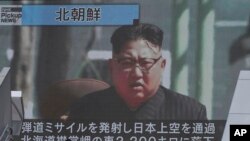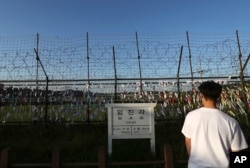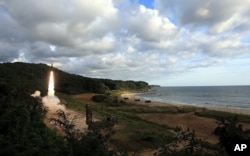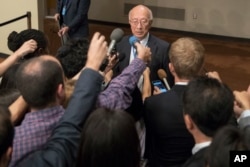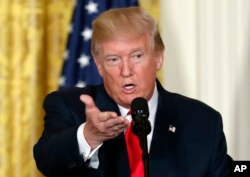President Donald Trump has responded to North Korea's most recent missile launch with a vow that the United States and its allies will not be intimidated.
Trump made the remark Friday during a speech to military personnel and their families at Joint Base Andrews in Maryland, just outside Washington.
He said North Korea's launch hours earlier showed Pyongyang's "utter contempt for its neighbors and for the entire world community."
Earlier in the day, NATO called for a global response to North Korea's latest launch of a missile, which flew over northern Japan just days after the United Nations imposed new sanctions on Pyongyang for conducting its sixth nuclear test.
NATO Secretary-General Jens Stoltenberg said on Twitter, "North Korea's missile launch is another reckless breach of U.N. resolutions — a major threat to international peace and security which demands a global response."
At the United Nations, the Security Council met behind closed doors for more than an hour. Afterward, in a statement, the council condemned the "highly provocative launch" and called on North Korea to reduce tensions on the peninsula. It also urged states to implement U.N. sanctions against Pyongyang, the latest round of which the council adopted Monday.
"We are discussing for a while that we are really in a vicious circle: We have a provocation, a resolution and then another provocation," Russian Ambassador Vassily Nebenzia told reporters.
'Stop it'
Nebenzia urged North Korea to "stop it" and said the only political proposal to resolve the standoff was the joint Russian-Chinese "freeze for freeze." That plan seeks to set the stage for a resumption of talks after Pyongyang suspends its nuclear and ballistic missile activity and the U.S. and South Korea suspend their joint military exercises.
The statement appeared unlikely to change North Korea's behavior. After the new sanctions were imposed Monday, North Korea called for the Security Council to be broken up, accusing it of being a "tool of evil" working for the United States.
The latest missile was launched from the Sunan district in Pyongyang and flew over the northern Japanese island of Hokkaido.
Yoshihide Suga, Japan's chief cabinet secretary, said, "We absolutely cannot accept these repeated provocations by North Korea and we strongly protest to North Korea and convey to them the nation's strong anger in the strongest words possible."
Warnings about the missile blared around 7 a.m. local time in the northern Japanese town of Kamaishi, according to footage from national broadcaster NHK.
South Korea's military reported the missile reached an altitude of about 770 kilometers (475 miles) and flew 3,700 kilometers (2,300 miles), far enough to reach the U.S. Pacific territory of Guam.
U.S. threat assessment
The U.S. Pacific Command said in a statement, "Initial assessment indicates the launch of an intermediate-range ballistic missile" that did not pose a threat to Guam.
The North American Aerospace Defense Command also determined that the missile had posed no threat to North America.
The South Korean military responded to the provocation from the North by launching a Hyunmoo-II missile into the sea that traveled the distance it would take to reach the Sunan airfield in Pyongyang, according to a military spokesman.
South Korean President Moon Jae-in also convened a National Security Council meeting to monitor the situation and prepare for any emerging threats from North Korea.
"President Moon ordered [the military] to closely analyze and increase the readiness posture against new types of threats from North Korea, such as EMP [electromagnetic pulse] and biochemical threats," presidential spokesman Park Su-hyun said.
North Korea said earlier this month it was developing a hydrogen bomb that could carry out an EMP attack. Experts disagree about whether the North had the capability to mount such an attack, which would involve setting off a bomb in the atmosphere that could heavily damage power grids and other infrastructure.
In August, North Korea launched a ballistic missile over Japan from a region near Pyongyang. That missile flew more than 2,700 kilometers at a maximum altitude of about 550 kilometers.
Japanese Prime Minister Shinzo Abe called for new sanctions "to be firmly imposed" in response to the latest North Korean missile test that violated Japanese airspace.
'New measures' urged
U.S. Secretary of State Rex Tillerson also called for "new measures" against North Korea and said, "These continued provocations only deepen North Korea's diplomatic and economic isolation."
"We call on all nations to take new measures against the Kim [Jong Un] regime," the top U.S. diplomat said.
Tillerson noted that China, which supplies North Korea with most of its oil, and Russia, as the largest employer of North Korean forced labor, have a unique responsibility in the diplomatic situation. "China and Russia must indicate their intolerance for these reckless missile launches by taking direct actions of their own," Tillerson said.
The North Korean state-run newspaper Rodong Sinmun on Friday said in an editorial, "If the U.S. continues to walk on the current course, we will take stronger actions for our self-defense."
A North Korean state agency threatened Thursday to use nuclear weapons to "sink" Japan and reduce the United States to "ashes and darkness" for supporting a U.N. Security Council resolution and sanctions over the latest nuclear test.
In the past two years, North Korea has conducted 27 ballistic missile launches and three nuclear tests.
At the beginning of this year, North Korea's Kim announced plans to develop an intercontinental ballistic missile that could strike the U.S. mainland.
The Trump administration has called the development of a North Korean ICBM an unacceptable existential threat. Washington has tried to work with Beijing to restrain the latter's ally in Pyongyang through economic sanctions.
While U.S. officials say they prefer a diplomatic solution to this nuclear standoff, military force is also an option.
VOA's U.N. correspondent Margaret Besheer and national security correspondent Jeff Seldin contributed to this report.




